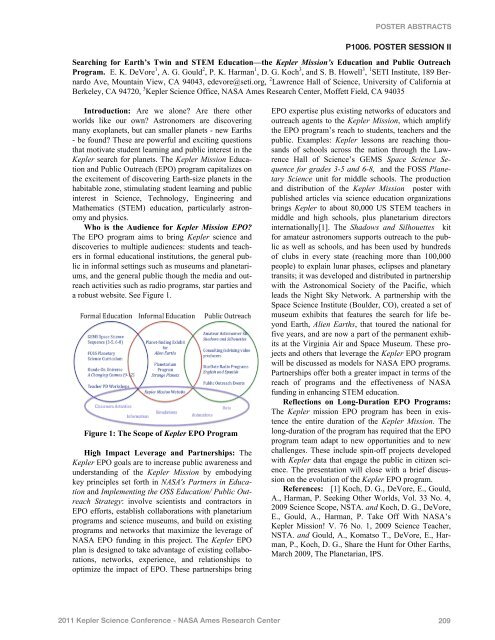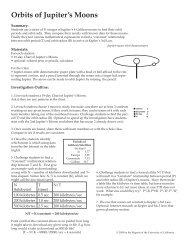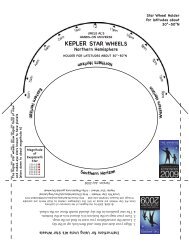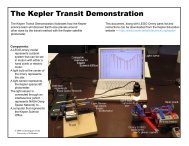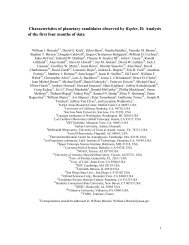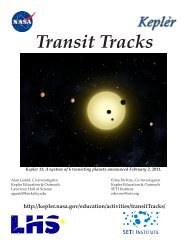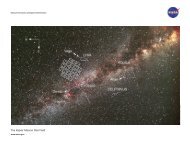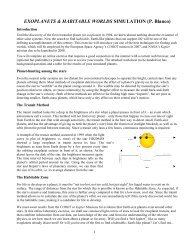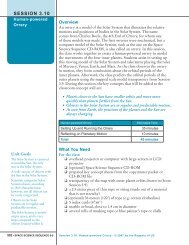Poster Abstracts - Kepler - NASA
Poster Abstracts - Kepler - NASA
Poster Abstracts - Kepler - NASA
- No tags were found...
You also want an ePaper? Increase the reach of your titles
YUMPU automatically turns print PDFs into web optimized ePapers that Google loves.
POSTER ABSTRACTSP1006. POSTER SESSION IISearching for Earth’s Twin and STEM Education—the <strong>Kepler</strong> Mission’s Education and Public OutreachProgram. E. K. DeVore 1 , A. G. Gould 2 , P. K. Harman 1 , D. G. Koch 3 , and S. B. Howell 3 , 1 SETI Institute, 189 BernardoAve, Mountain View, CA 94043, edevore@seti.org, 2 Lawrence Hall of Science, University of California atBerkeley, CA 94720, 3 <strong>Kepler</strong> Science Office, <strong>NASA</strong> Ames Research Center, Moffett Field, CA 94035Introduction: Are we alone? Are there otherworlds like our own? Astronomers are discoveringmany exoplanets, but can smaller planets - new Earths- be found? These are powerful and exciting questionsthat motivate student learning and public interest in the<strong>Kepler</strong> search for planets. The <strong>Kepler</strong> Mission Educationand Public Outreach (EPO) program capitalizes onthe excitement of discovering Earth-size planets in thehabitable zone, stimulating student learning and publicinterest in Science, Technology, Engineering andMathematics (STEM) education, particularly astronomyand physics.Who is the Audience for <strong>Kepler</strong> Mission EPO?The EPO program aims to bring <strong>Kepler</strong> science anddiscoveries to multiple audiences: students and teachersin formal educational institutions, the general publicin informal settings such as museums and planetariums,and the general public though the media and outreachactivities such as radio programs, star parties anda robust website. See Figure 1.Figure 1: The Scope of <strong>Kepler</strong> EPO ProgramHigh Impact Leverage and Partnerships: The<strong>Kepler</strong> EPO goals are to increase public awareness andunderstanding of the <strong>Kepler</strong> Mission by embodyingkey principles set forth in <strong>NASA</strong>'s Partners in Educationand Implementing the OSS Education/ Public OutreachStrategy: involve scientists and contractors inEPO efforts, establish collaborations with planetariumprograms and science museums, and build on existingprograms and networks that maximize the leverage of<strong>NASA</strong> EPO funding in this project. The <strong>Kepler</strong> EPOplan is designed to take advantage of existing collaborations,networks, experience, and relationships tooptimize the impact of EPO. These partnerships bringEPO expertise plus existing networks of educators andoutreach agents to the <strong>Kepler</strong> Mission, which amplifythe EPO program’s reach to students, teachers and thepublic. Examples: <strong>Kepler</strong> lessons are reaching thousandsof schools across the nation through the LawrenceHall of Science’s GEMS Space Science Sequencefor grades 3-5 and 6-8, and the FOSS PlanetaryScience unit for middle schools. The productionand distribution of the <strong>Kepler</strong> Mission poster withpublished articles via science education organizationsbrings <strong>Kepler</strong> to about 80,000 US STEM teachers inmiddle and high schools, plus planetarium directorsinternationally[1]. The Shadows and Silhouettes kitfor amateur astronomers supports outreach to the publicas well as schools, and has been used by hundredsof clubs in every state (reaching more than 100,000people) to explain lunar phases, eclipses and planetarytransits; it was developed and distributed in partnershipwith the Astronomical Society of the Pacific, whichleads the Night Sky Network. A partnership with theSpace Science Institute (Boulder, CO), created a set ofmuseum exhibits that features the search for life beyondEarth, Alien Earths, that toured the national forfive years, and are now a part of the permanent exhibitsat the Virginia Air and Space Museum. These projectsand others that leverage the <strong>Kepler</strong> EPO programwill be discussed as models for <strong>NASA</strong> EPO programs.Partnerships offer both a greater impact in terms of thereach of programs and the effectiveness of <strong>NASA</strong>funding in enhancing STEM education.Reflections on Long-Duration EPO Programs:The <strong>Kepler</strong> mission EPO program has been in existencethe entire duration of the <strong>Kepler</strong> Mission. Thelong-duration of the program has required that the EPOprogram team adapt to new opportunities and to newchallenges. These include spin-off projects developedwith <strong>Kepler</strong> data that engage the public in citizen science.The presentation will close with a brief discussionon the evolution of the <strong>Kepler</strong> EPO program.References: [1] Koch, D. G., DeVore, E., Gould,A., Harman, P. Seeking Other Worlds, Vol. 33 No. 4,2009 Science Scope, NSTA. and Koch, D. G., DeVore,E., Gould, A., Harman, P. Take Off With <strong>NASA</strong>’s<strong>Kepler</strong> Mission! V. 76 No. 1, 2009 Science Teacher,NSTA. and Gould, A., Komatso T., DeVore, E., Harman,P., Koch, D. G., Share the Hunt for Other Earths,March 2009, The Planetarian, IPS.2011 <strong>Kepler</strong> Science Conference - <strong>NASA</strong> Ames Research Center 209


